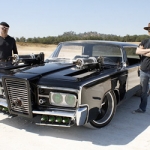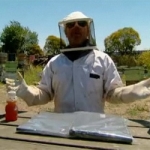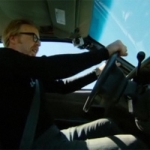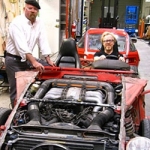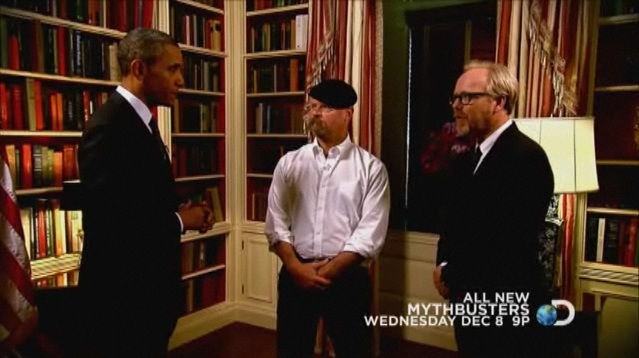
Episode: MythBusters 8.27 — “President’s Challenge”
Original Air Date: December 8, 2010
When the President of the United States has a burning science question that must be answered, who does he call? The MythBusters, of course. Because, you know, his advisers who are actual professional scientists just aren’t as cool as Jamie and Adam and don’t blow up enough things, I guess. In this episode, Mr. Obama presents the daring duo with a challenge: revisit the Archimedes Death Ray myth one more time and see if you can bust it when you use 500 people with mirrors instead of the measly 300-mirror array from the last revisit. Will that make a difference? We’ll see. Kari, Grant, and Tori are relegated to the movie myth bargain bin once again — will they get a different result than usual when they take on a scene from Hellboy where a punch to the hood of a car makes it somersault over his head? Keep reading to find out.
Myth #1: Ancient Greek scientist Archimedes once saved his city from marauding Romans with a “Death Ray” of mirrors that used the power of reflected sunlight to set fire to the Roman ships.
MythBusters: Adam and Jamie
Procedure:
- Figure out a way for someone holding a mirror to aim the sun’s reflection from it at a particular point with small scale experiments in the workshop.
- Perform a medium scale experiment with the most viable option: have twelve people use mirrors to try to aim the sun’s reflection at a target and hold it there for 60 seconds, both with and without some kind of screen or netting that allows the mirror-holder to see the reflection and the target at the same time. Use a still camera and a thermal imaging camera to determine the efficacy of the aiming method.
- Create a mock-up of a Roman ship with a sail. Get 500 modern glass mirrors and adhere thin mylar sheets to the back to simulate ancient bronze mirrors. Find 500 middle and high school students to play Greek soldiers. Put up a long line of metal screen fencing along the shoreline of a nearby body of water.
- Anchor the boat 400 feet from shore. Distribute the double-sided mirrors to the 500 students and line them up along the shore. Have them aim the bronze side of their mirrors at the designated spot on the boat’s sail and wait to see if it ignites. Use a thermal imaging camera to determine the temperature at the target spot.
- If the bronze mirrors fail to ignite the sail, switch to the modern glass mirrors and repeat step 4.
- If the sail is still not on fire, move the boat to a position 100 feet from shore and repeat step 4 with modern mirrors.
- Analyze the results.
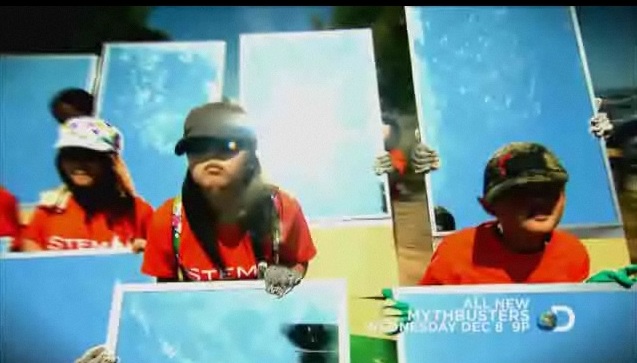
Results: In medium scale tests, Adam’s aiming net worked much better than no aiming system at all. Without the net, the 12 people covered 35% of the target area with reflected sunlight, as shown in still photographs, and according to the thermal imaging camera, they were able to raise the temperature of the target circle to 90 degrees after 60 seconds. With the aiming net, after 60 seconds the still photos showed only 10% coverage, meaning the beams were more concentrated on the target circle, which resulted in a higher temperature at that spot (150 degrees). This proves that the aiming net works as intended.
In the first large scale test (500 bronze mirrors, boat 400 feet away) the temperature at the target increased by 45 degrees to 130 degrees after 15 minutes of concentrated sunlight reflection. Using modern mirrors, the temperature increased to 200 degrees. When the boat was moved 300 feet closer to shore, the thermal camera registered a temperature of 280 degrees.
Conclusion: The temperature of the sail must reach 410 degrees Fahrenheit in order for it to catch on fire. None of the full scale tests came anywhere close to producing temperatures high enough to ignite the sail — the hottest was still more than 100 degrees cooler than the needed temperature. For the third time, this myth is busted. The only way that 500 Greeks with mirrors could possibly have managed to defeat the Roman navy would be by blinding, dazzling, or otherwise distracting them with the mirror reflections.
Myth #2: A superhero can punch a car’s hood with so much force that the car’s wheels act as a pivot point for flipping the car upside down and over the superhero’s head, as seen in the movie Hellboy.
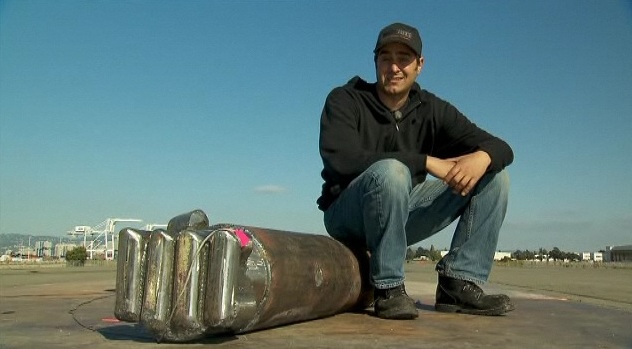
MythBusters: Kari, Grant, and Tory
Procedure 1:
- Measure the impact of a fictional creature’s punch: determine the amount of weight needed to push the front end of an SUV into the ground. Plug that number into complicated mathematical equations to determine how much weight is needed to produce the same effect when dropped from a crane 20 feet above the vehicle.
- Create a large metal fist that weighs the amount determined in step 1. Suspend it from a crane. Set up a pressure sensor that will release the fist from the crane when the subject vehicle runs over it.
- Tow an SUV so that it goes over the pressure sensor and under the suspended fist. Observe the vehicle for signs of flipping over.
- Make adjustments as necessary to make sure the fist hits the front of the vehicle.
- Repeat steps 3 and 4 until it works or until you run out of cars, whichever comes first.
- Observe and analyze the results.
Results: 5000 lbs. were required to push the front end of an SUV down to the ground, which means that (according to MythBusters calculations) the weight of the dropped fist should be 1500 lbs.
The first three SUVs to go under the hammer were either missed or hit in the wrong place. After a cable guidance system is installed to keep the towed target vehicle on the right course, the fist finally hit the front of the very last SUV available for these tests. The back wheels did not leave the ground.
Conclusion: Myth busted — in this case, when the SUV flips over, it is acting like a lever, with the front axle as the fulcrum. The front end of the car is too close to the fulcrum to be able to lift the back end of the car when weight is applied to it — it is like trying to lift a person sitting on one end of a see-saw by sitting close to the middle of it — the closer to the fulcrum, the greater the weight has to be to move the weight on the other end. Since this is MythBusters, however, it’s time to do some small-scale tests to see what the ideal somersault car would look like and then try to build and test it full-scale.
Procedure 2:
1. Using a remote-controlled SUV and a suspended weight that is half the weight of the vehicle, drop the weight onto the front of the car while it is traveling at a slow speed and observe the rear wheels to see if they leave the ground. Repeat with the vehicle traveling at a fast speed.
2. With the RC vehicle traveling at the ideal speed as determined in step 1, try dropping different amounts of weight onto the vehicle and observe the rear wheels to see how far they leave the ground.
3. Using the ideal weight and speed as determined in steps one and two, change the vehicle’s center of gravity by adding a luggage rack on top and repeat the experiment.
4. Change the vehicle design to try to replicate the movie stunt.
5. If the small scale model works, make a full scale prototype and drop the heaviest weight possible onto the car to see if it flips over.
Results: When varying only the speed of the vehicle, the back wheels did not leave the ground at the slow speed but achieved two degrees of rear wheel elevation when the vehicle was traveling at a fast speed. When varying the weight, the weight that was three times heavier than the vehicle stopped it, but the wheels didn’t leave the ground. When using a weight that was twice the weight of the vehicle, the rear wheels achieved a 15 degree angle of elevation. When the luggage rack is added, moving the center of gravity to a point higher on the vehicle, the rear wheels reach a 25 degree angle of elevation. The vehicle never flips over.
The altered vehicle design featured a platform at roof level cantilevered out over the hood of the car. In the small scale test, when the weight was dropped, the rear wheel angle of elevation was more than 90 degrees, which is what is needed to cause the vehicle to flip over. In full scale, dropping a 5000 lb. weight onto the car, the weight was triggered at the right time and hit the correct spot on the vehicle, but achieved only a 45 degree rear wheel elevation and no flip.
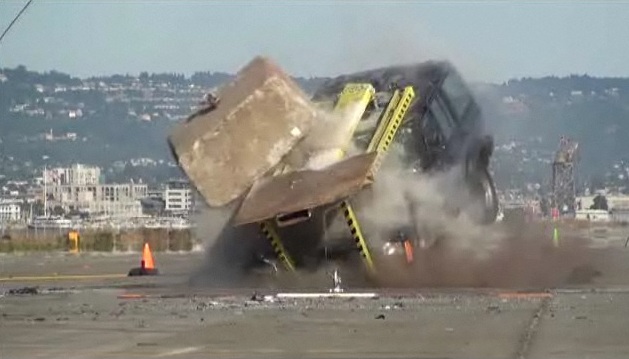
Conclusion: According to Kari, Grant, and Tory, this myth is busted.
Episode Conclusions: Where do I start? This episode was ridiculous in so many ways. Excuse me, Mr. President? If you want to meet the MythBusters and tell them what great fans you and your daughters are and challenge them to bust or prove a myth, could you not do better than one that they busted a long time ago, both the first time they did it and on a revisit where they were helped by MIT students who are presumably on their way to becoming actual scientists and not just special effects builders? Could you not come up with something more original or more in question or at least involving firearms or explosives? As for President Obama’s reasoning — to encourage young people in America to become interested in science — those who are trained in the field of education, like I am, have it drilled into them that the way to get students really engaged in something is to make it applicable to real life. So why are we busting an ancient Greek weapon myth that, while interesting, really has no bearing on 21st century life, when we could be designing and testing prototypes to solve real world problems, similar to what Jamie did with his personal tornado shelter in the “Storm Chasing Myths” episode?
As for the secondary team — once again they are stuck with a movie myth, and this time it’s not even remotely connected to a real world situation. Kari, Grant, and Tory manage to look like they are excited and having fun while they try to replicate movie special effects that invariably end up busted, but surely they are just as tired of tackling them as I am of seeing them. Save it for spectacular things, like the bus bridge jump from Speed and stop wasting time on other things, like whether or not a superhero could punch a car hard enough to make it flip over his head. How can you actually say that it’s busted? Yes, as a real life situation it’s obviously busted, but since Hellboy is a fictional superhero character, who’s to say whether or not he can punch the car with enough force to make it flip over his head like that? Obviously he can, because he did in the movie. That’s like trying to prove or bust whether Superman can leap tall buildings in a single bound. MythBusters is normally so much better than this. I hope they are back up to snuff very soon, though from the promos I’ve glanced at on the show’s website it looks like they’re jumping on the new movie promotion bandwagon and wasting a whole episode on superhero special effects. Sigh.
Rating: 1 / 5 Stars



